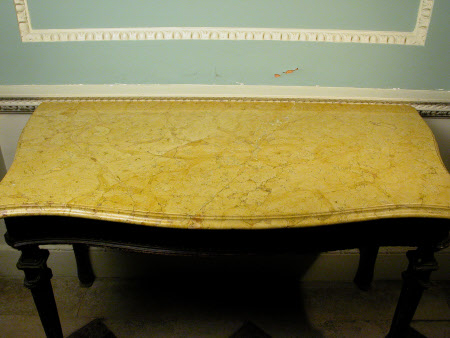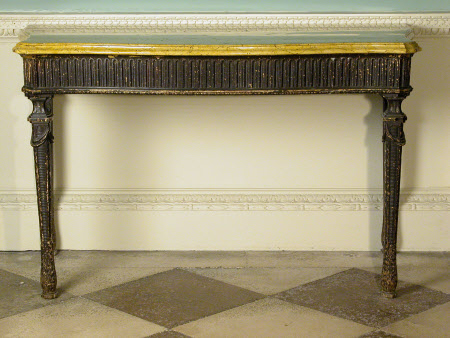Untitled
Category
Furniture
Date
circa 1760 - circa 1770
Materials
Marble, hardboard, mahogany, softwood, gilt, paint
Place of origin
England
Order this imageCollection
Saltram, Devon
NT 871273
Summary
A pair of marble-topped serpentine side tables, English, circa 1760 - 1770, one of a pair, originally gilt (some of which remains beneath the later coat of 'mahogany'-coloured paint). Robert Adam (1728 - 1792) has been considered the designer of these tables, but there is no documentary evidence to support this attribution.
Full description
The legs of these tables are very similar to the legs of the pair of very good quality mahogany card tables at Saltram [N 871340.1 - .2]. Both legs start at the top as square-section but become round-section as they descend along their length. Both, too, are topped by a waisted capital above a concave section before the leg proper begins. The capital and the main section of both legs are decorated to each side with an outlined reserve. To the pair of card tables the reserves are left plain; to these side tables the reserves to both legs and capitals are decorated with horizontal reeding, sometimes known as 'match-strike' decoration. In addition, all of these table legs share a carved drapery swag issuing from the very top of the leg proper. To all four tables the lowest point of this swag sits across the corner of the leg, not the side. Lastly, all four legs have concave corners or angles which are filled with a carved chain of pendant harebells which terminates about half-way down the length of the leg. At this point, all four legs become more slender before flaring out to form a bulb. The treatment of the feet is different - the card tables have an additional bulb forming a foot proper, whilst these side tables have a simple straight-sided plinth beneath the lowest swelling on the leg - but the similarities described here suggest a common designer or maker, as yet unidentified. (Megan Wheeler, 2017)
Provenance
Date of introduction to Saltram not recorded but at Saltram by 1951 and accepted by HM Treasury in lieu of full payment of Death Duty from the Executors of Edmund Robert Parker (1877 - 1951), 4th Earl of Morley and transferred to the National Trust in 1957.



